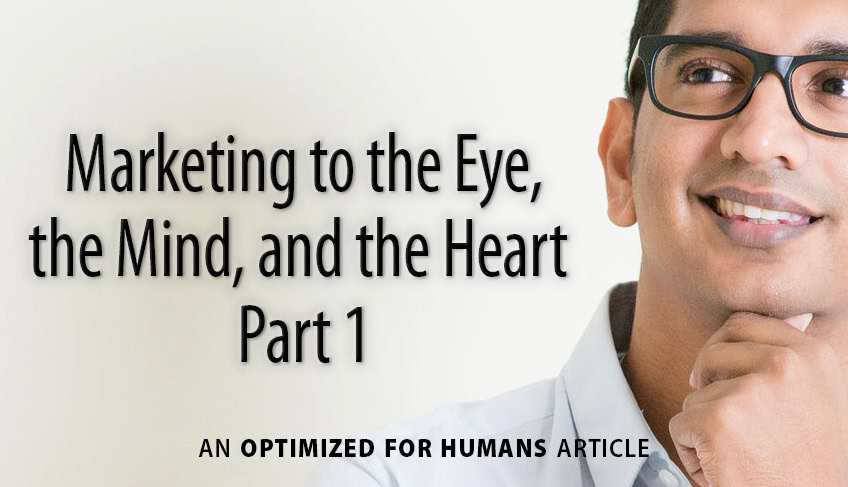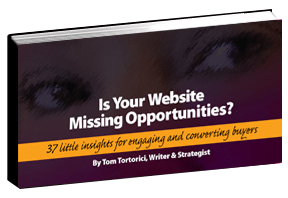
B Y T O M T O R T O R I C I
Throughout my career as a writer, designer, and marketing guy, it’s funny, I’ve come to see myself as being in the persuasion business. I mean, a company can have a smartly-designed, easy to navigate, carefully-worded website. But if it’s not persuading visitors to respond in some way, well, what’s the point?
Companies understandably work hard to optimize their sites for search engines. But ultimately, search engines don’t make purchase decisions; humans do. Which is why websites should also be optimized for humans.
Let me tell you about my experiment, okay? As an agency Creative Director years ago, I had a chance to teach a class in strategic messaging to some very creative young marketing writers.
But I didn’t want to bore them with the ‘principles of marketing.’ Instead, I wanted to prepare by digging a little deeper myself into how buyers and sellers interacted in the real world. So I began an experiment. I started observing myself consuming all kinds of media.
For example, I noticed that a certain website was interesting; it drew me in, and made me think. However the last several sites I had visited got only a quick glance before I hit the Back button.
Why?
I paid close attention to what caught my eye, as well as my own internal response, and what, if anything, I did next. I began applying that internal scrutiny to everything from promo emails and social media graphics to direct mail pieces and ads in the Sunday paper.
And all too often, I found my eye sliding off the pages with nothing noteworthy enough to retain it. Every time I clicked away from a ho-hum website, I thought, the web designer approached this site from a design perspective; the company manager approached it from an internal business perspective; but you know what? I don’t think anyone really approached it from the visitors’ perspective.
It became clear that website creators and website visitors see that same site in a very different light.
And of course with the piles of information we each come across every day, it can’t all make it to the foreground of our awareness. Most of it is just background … which means we don’t notice it at all.
It was a fascinating experiment. I learned things about myself as a buyer that surprised me. And by assuming the buyer’s point-of-view, I think I became a better seller. And in the end, although I was preparing lessons for others, I was the one who got the education.
Below, I’d like to share some of the ideas I kind of stumbled across. I’ll mix in some of what I’ve learned from web marketers who are smarter than me. And I’ll include a bit of applied common sense. See what you think.
So how do we make our websites and other marketing pieces part of the foreground? As far as I can tell, we have to appeal to the Eye, the Mind, and the Heart. And why is that? Here’s what I think.
The Eye: When a visitor lands on your website, if what they see doesn’t grab them pretty darn quickly, it doesn’t matter what else is on your site, because they’re already gone, looking elsewhere.
The Mind: We’re continually processing the challenges and issues in our business and personal lives. if you land on a website that quickly taps into what you were just thinking or wondering about – there’s an instant connection.
And the Heart: One of the biggest revelations of my experiment is that just about every purchase decision has an emotional component. In fact, neuroscientists say that humans quickly reach decisions based on an emotional reaction … then choose the facts later that support that decision. Interesting.
So let’s look closer at how to appeal to the Eye, the Mind, and the Heart, especially in our websites. As they say, we only have one chance to make a first impression. So let’s make it count, shall we?
Appealing to the Eye
When you land on a new company Home page, do you typically read every word top to bottom, as if it were a page in a novel? More likely, your attention initially darts around, scanning for something worth digging into. If nothing really stands out, you might find your eyes glazing over. Happens all the time, right?
Smart web designers don’t just arrange the content bits to nicely fit on the page. They create multiple points of focus to capture the scanning eye. Typically, readers first notice an image, which draws their eye to the intriguing or persuasive written message it’s paired with.
If you have nothing else to show, consider an authentic-looking photo of someone smiling, perhaps as they interact, or use the product. Not to get too cheesy, but almost from birth, humans have a visceral attraction to faces, and the emotions they reveal. A web page showing people simply seems warmer than one that doesn’t.
Now, it’s a fact that web visitors read headlines far more often than they read small text. So take advantage of those prime plots of web page real estate to quickly get across your most important product benefits. Otherwise, a scanner who glances at an empty headline like “Why Choose Us” will have learned nothing.
Next, perhaps draw folks in further by adding a medium-size ‘sub-head’ that acts as a kind of visual bridge between the headline and text. That sub-head can make a key secondary point, or ask a pointed question to build curiosity.
Overall, treat business Home pages as simply as a brief intro to your product or service, which means bite-size, easily-absorbable chunks of information, rather than multiple running paragraphs.
Save the longer explanatory text for the other web pages, but don’t make the common mistake of putting obstacles in the reader’s way. How? With body text that’s too small, too wide, or too tightly spaced to be easily read. If you want people to do something, for heaven’s sake, make it easy for them.
Finally, remember to keep all important content toward the center of the web page, because the eye doesn’t typically roam toward the edges. Links at the upper right corner, or a block of text that starts at the extreme left of the page, are often ignored … which means opportunity is missed.
To be continued in Marketing to the Eye, the Mind, and the Heart – Part 2.
Share It:
 About the Author: Tom Tortorici is an Atlanta copywriter and web content writer who helps companies make a genuine connection with their audience. His classes and conference presentations have focused on how writing, strategy and design can work together to grab attention and interest even among readers with short attention spans. In addition to working directly with businesses, Tom regularly partners with web designers and marketing agencies.
About the Author: Tom Tortorici is an Atlanta copywriter and web content writer who helps companies make a genuine connection with their audience. His classes and conference presentations have focused on how writing, strategy and design can work together to grab attention and interest even among readers with short attention spans. In addition to working directly with businesses, Tom regularly partners with web designers and marketing agencies.
All Posts/Subscribe >
Info for Businesses >
Info for Designers/Agencies >
Tom Tortorici Inc. | Tom@TomTortorici.com | 770-934-7861 | 3101 Rockaway Rd | Atlanta GA 30341

